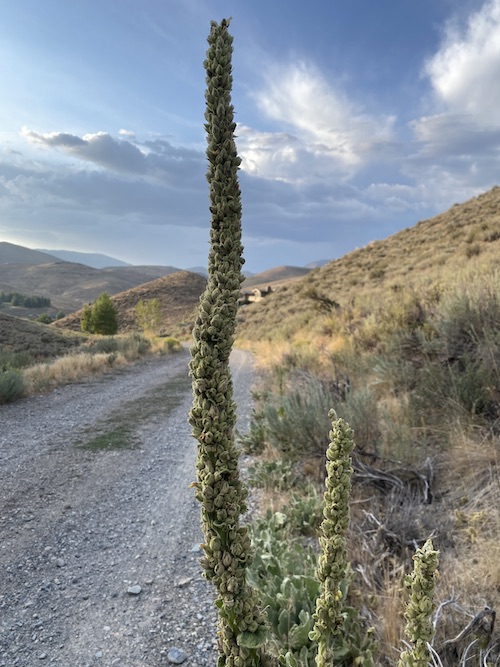BY HARRY WEEKES
They spring up seemingly overnight—pillars distinct against the low backdrop of sage and bitterbrush. Unlike high-rises that humans build, which seem as much monuments to the builder and to engineering as anything else, these high-rises can go almost completely unnoticed, even when all the lights are on. I am talking about mullein, which has been on my mind for multiple reasons.
First. An increasingly distant memory of childhood spurred by the start of school. Walking out Indian Creek, I pass the first bus stop on one driver’s route. When I was at Hemingway, these routes were color-coded for kids, but I’m sure they have a different technical name in the Bus Barn, like “Indian Creek.”
The Indian Creek bus picks up its first riders at 6:45 a.m., making the bus an interesting clock; letting me know roughly what time it is wherever I might be on my route.
A bus like this used to drop my siblings and me off in Gimlet when we were kids (and when I managed to remember both that I was supposed to ride the bus and also what color I was supposed to be on). Gimlet then was a wee bit different, with our house being one of perhaps 10 or so, and we were four of six kids on our section of road … which happened to be the longest.
The bus dropped us right after the bridge and we walked from there—probably about a mile to our house. Each of these mini-treks was a fantastic field trip and the fall invariably had Jack, my brother, and me breaking off dried mullein stalks and fencing all the way home. OK, we would fence for about thirty yards until we broke the stalks and had to find others.
The first bus this year passed me last week and I smiled fondly at my former self dancing around with a mullein epee.
Second. There is a particularly fantastic mullein growing on our driveway. A trophy mullein, based on its size. With one central stalk and several adjoining spires, it represents a favorite waypoint on my walks down the road. I make a beeline towards it when it comes into view, because of the third reason.
Third. The lights. For mullein, the lights are its flowers which, when on, glow on the central stalk, making the whole plant a buttery beacon. Walking up to the trophy mullein revealed not only the beauty of the plant but the other important element of any high-rise—its inhabitants. There were bees, wasps, ants, various grasshoppers, butterflies, and skippers. Vowing to photograph them on my next walk was delayed by going out too early, then too late in the day, and then too late in the season. By the time I remembered to bring my phone, the lights were off. The flowers were gone and the stalk was covered with closed popcorn-like pods.
It also appeared that new renters had moved in—larger grasshoppers and mice (whose evidence was a kind of natural vandalism—leaves chewed, the stalk nibbled, their droppings left behind).
From here, I know what happens; the great velvety leaves at the base will dry as the stalk does and the plant will become a kind of derelict brown reminder of the growing season. Mullein was and is used for many things, and is known to help with sore throats, colds, coughs, and “afflictions related to the lungs.”
Variously, my brother convinced me it was Indian toilet paper and chewing gum—you can gnaw on the dried inner material of the stalk (not particularly delicious and no bubbles).
For me, like its inhabitants, more than a hundred uses, it is a hundred stories, whispered from the side of the road.
Harry Weekes is the founder and head of school at The Sage School in Hailey. This is his 53rd year in the Wood River Valley, where he lives with Hilary and two mini-Dachshunds. The baby members of their flock have now become adults—Georgia and Simon are fledging in North Carolina, and Penelope is fledging in Vermont.



